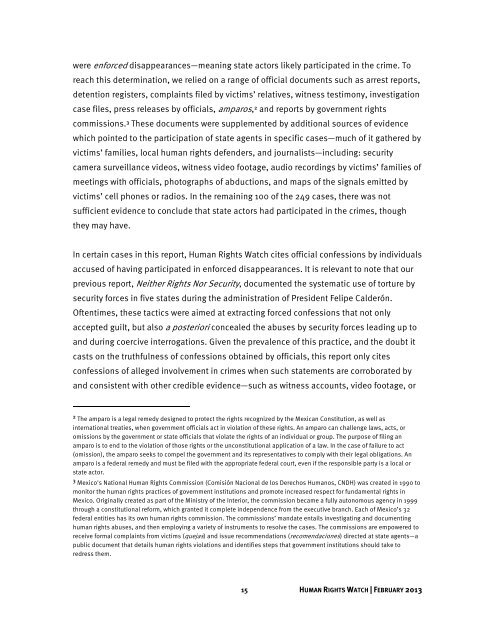Download the full report - Human Rights Watch
Download the full report - Human Rights Watch
Download the full report - Human Rights Watch
You also want an ePaper? Increase the reach of your titles
YUMPU automatically turns print PDFs into web optimized ePapers that Google loves.
were enforced disappearances—meaning state actors likely participated in <strong>the</strong> crime. To<br />
reach this determination, we relied on a range of official documents such as arrest <strong>report</strong>s,<br />
detention registers, complaints filed by victims’ relatives, witness testimony, investigation<br />
case files, press releases by officials, amparos, 2 and <strong>report</strong>s by government rights<br />
commissions. 3 These documents were supplemented by additional sources of evidence<br />
which pointed to <strong>the</strong> participation of state agents in specific cases—much of it ga<strong>the</strong>red by<br />
victims’ families, local human rights defenders, and journalists—including: security<br />
camera surveillance videos, witness video footage, audio recordings by victims’ families of<br />
meetings with officials, photographs of abductions, and maps of <strong>the</strong> signals emitted by<br />
victims’ cell phones or radios. In <strong>the</strong> remaining 100 of <strong>the</strong> 249 cases, <strong>the</strong>re was not<br />
sufficient evidence to conclude that state actors had participated in <strong>the</strong> crimes, though<br />
<strong>the</strong>y may have.<br />
In certain cases in this <strong>report</strong>, <strong>Human</strong> <strong>Rights</strong> <strong>Watch</strong> cites official confessions by individuals<br />
accused of having participated in enforced disappearances. It is relevant to note that our<br />
previous <strong>report</strong>, Nei<strong>the</strong>r <strong>Rights</strong> Nor Security, documented <strong>the</strong> systematic use of torture by<br />
security forces in five states during <strong>the</strong> administration of President Felipe Calderón.<br />
Oftentimes, <strong>the</strong>se tactics were aimed at extracting forced confessions that not only<br />
accepted guilt, but also a posteriori concealed <strong>the</strong> abuses by security forces leading up to<br />
and during coercive interrogations. Given <strong>the</strong> prevalence of this practice, and <strong>the</strong> doubt it<br />
casts on <strong>the</strong> truthfulness of confessions obtained by officials, this <strong>report</strong> only cites<br />
confessions of alleged involvement in crimes when such statements are corroborated by<br />
and consistent with o<strong>the</strong>r credible evidence—such as witness accounts, video footage, or<br />
2 The amparo is a legal remedy designed to protect <strong>the</strong> rights recognized by <strong>the</strong> Mexican Constitution, as well as<br />
international treaties, when government officials act in violation of <strong>the</strong>se rights. An amparo can challenge laws, acts, or<br />
omissions by <strong>the</strong> government or state officials that violate <strong>the</strong> rights of an individual or group. The purpose of filing an<br />
amparo is to end to <strong>the</strong> violation of those rights or <strong>the</strong> unconstitutional application of a law. In <strong>the</strong> case of failure to act<br />
(omission), <strong>the</strong> amparo seeks to compel <strong>the</strong> government and its representatives to comply with <strong>the</strong>ir legal obligations. An<br />
amparo is a federal remedy and must be filed with <strong>the</strong> appropriate federal court, even if <strong>the</strong> responsible party is a local or<br />
state actor.<br />
3 Mexico's National <strong>Human</strong> <strong>Rights</strong> Commission (Comisión Nacional de los Derechos <strong>Human</strong>os, CNDH) was created in 1990 to<br />
monitor <strong>the</strong> human rights practices of government institutions and promote increased respect for fundamental rights in<br />
Mexico. Originally created as part of <strong>the</strong> Ministry of <strong>the</strong> Interior, <strong>the</strong> commission became a <strong>full</strong>y autonomous agency in 1999<br />
through a constitutional reform, which granted it complete independence from <strong>the</strong> executive branch. Each of Mexico’s 32<br />
federal entities has its own human rights commission. The commissions’ mandate entails investigating and documenting<br />
human rights abuses, and <strong>the</strong>n employing a variety of instruments to resolve <strong>the</strong> cases. The commissions are empowered to<br />
receive formal complaints from victims (quejas) and issue recommendations (recomendaciones) directed at state agents—a<br />
public document that details human rights violations and identifies steps that government institutions should take to<br />
redress <strong>the</strong>m.<br />
15 HUMAN RIGHTS WATCH | FEBRUARY 2013

















